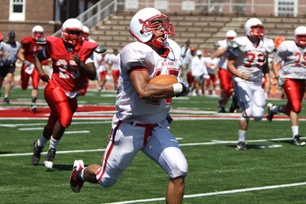Jim Amidon — I walked across the Wabash College campus Friday morning so I could check up on the progress at Hollett Little Giant Stadium. Various crews have been working to install a new synthetic playing surface, scoreboard, and give the 44-year-old stadium a facelift.
All those soaking thunderstorms in June slowed the progress of what was already a pretty tight timeline. As of mid-day Friday, there was still a huge pile of white sand and several large containers of granulated rubber still to be applied to the Field Turf surface.

Somehow, though, the crews got finished enough so the Little Giant football team could take the state-of-the-art surface for a test drive Saturday afternoon in a little offense vs. defense scrimmage.
After all these years hanging around Wabash’s football program (28 this year), very little surprises me any more. But the transformation of Hollett Little Giant Stadium ranks up near the top.
I have always been proud of Wabash’s facilities. Hays Hall is a state-of-the-art science building; Trippet Hall is a beacon at the north end of campus; the Fine Arts Center is one of the finest of its kind for a school our size; and renovations of Goodrich and Baxter halls create ideal teaching and learning conditions.
The Allen Athletics and Recreation Center, dedicated less than 10 years ago, provides 170,000 square feet of space for intramurals, recreation, and the varsity sports of basketball, swimming, wrestling, and indoor track. It’s a stunning building for a college of any size.
Over time, though, the College’s outdoor athletic facilities didn’t match up with all the other improvements to campus.

For over 50 years, Mud Hollow has been the all-purpose green grass area of campus, home to the baseball team in the spring and the soccer team in the fall. The football team practiced there for decades. In comparison with many schools against which Wabash competes (for students and in sports), the baseball and soccer facilities were, in a word, shabby.
That’s not meant to knock the hard work coaches and groundskeepers have put into the baseball and soccer fields. They’ve done remarkable work, especially considering that Mud Hollow is by a large measure the lowest part of campus, which makes for mucky conditions in the spring.
All of that is changing.
It’s my job to hype up all things Wabash. The new football field needs no hype. One look says it all.
The Field Turf is a deep, lustrous green with bright red Wabash lettering and a bold W in the center of the field. It will never need to be watered or painted or fertilized. It will reduce injuries to players. It will be gorgeous year-round.
And I can’t wait to see what it looks like in November when HDNet broadcasts the Monon Bell Game in high definition!
The transformation of Hollett Stadium is just the beginning.
The baseball stadium construction is well underway on the southwest side of campus. When I drove by last week, I saw the massive piles of dirt being spread to level that part of campus for the baseball field. There’s a tall post stuck in the ground near the corner at Jennison Street; that’s where home plate will be. I decided to get out of the car and check it out. It was a pretty cool feeling to stand at home plate and imagine what the new stadium will look like when it opens in March.
Baseball Coach Cory Stevens works as hard as any recruiter at Wabash, and he’ll soon have a showpiece stadium to match his efforts.
Finally, as soon as the soccer season ends, workers will begin the long process of leveling Mud Hollow Field, which slopes to the south by about four or six feet from one end to the other. Once they get it level (talk about moving a lot of dirt), the crew from Field Turf will return to put down a synthetic soccer field, which will be the first step in the construction of a new soccer stadium on the western edge of Mud Hollow.
The rest of Mud Hollow will be a combination of synthetic and natural grass practice and intramural fields.
By this time next year, all of the construction on new outdoor athletic facilities will be complete.
A little over 40 percent of all Wabash students participate in intercollegiate sports; over 80 percent play intramurals. A year from now, all will enjoy outdoor facilities that match the high quality of the classrooms, laboratories, art galleries, and concert halls.
I hope you’ll plan now to share our pride in Wabash and attend the Community Day football game against Wooster on September 11. Admission is free and believe me, there is no finer place to watch a football game any where.